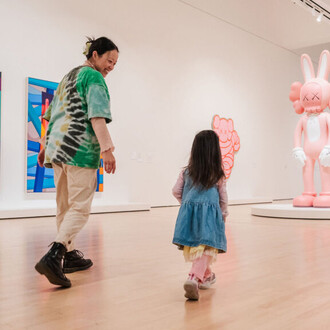In the spring of 1980, six years before Mikhail Gorbachev introduced “glasnost” to the Soviet Union, Modernism gallery brought Russian avant-garde [1910-1930] art to the West Coast of the United States. Barely six months old and situated in a large, minimalist-designed, second-floor space in San Francisco’s then edgy South of Market district, Modernism defied censorship in the USSR and provincialism in San Francisco with a museum-quality exhibition that included works by Kazimir Malevich, Liubov Popova, Alexander Bogomazov and a dozen other seminal artists working in the teens and twenties.
The historical exhibition provided crucial context for the gallery’s presentation of contemporary abstract artists including David Simpson, Frederick Hammersley and James Hayward, whose paintings reciprocally enriched the rarely seen work of the Soviet artists who pioneered abstraction in the heady decades ahead of Stalinist oppression. In the fledgling SOMA district gallery, past, present and future formed a creative continuum.
Forty-five years later, resituated in a bespoke street-level space in San Francisco’s Tenderloin, Modernism continues to bring art of historical importance into dialogue with the most recent advances worldwide. Gallery founder and owner Martin Muller has expanded the program to include virtually every significant 20th and 21st century movement, from Dada, Cubism, Surrealism, Vorticism and German Expressionism to Pop, Formal Abstraction, Photorealism and Conceptualism.
In celebration of the 45th anniversary, Modernism is pleased to present a two-part retrospective showcasing dozens of the artists whose work has defined the gallery, enhanced cultural life in the city and contributed to art history. Opening on July 5, Part I will be on view until August 31. Part II is scheduled to open in September.
The Russian avant-garde, which Modernism has presented in twenty historical exhibitions —including masterpieces such as Kazimir Malevich’s 1917-18 canvas Supremus no. 84 —is represented in Part I with work by many of the artists featured in 1980. Highlights include Malevich’s important study for Samovar II (1913), a multifaceted Cubo-Futurist painting shown in his 1919 retrospective and currently in MoMA’s permanent collection. Also noteworthy is Popova’s oil-pastel study for Spatio-dynamic construction (1921), a “tour-de-force” of pure abstraction in which the artist audaciously set geometry in motion. A third work of particular significance is Cubo-futurist landscape with man walking, a 1914 charcoal drawing by Bogomazov that boldly walks the line between figuration and abstraction, questioning where one ends and the other begins. (A Ukrainian artist from Kyiv, Bogomazov received his first US retrospective at Modernism in 1983.)
Contemporary abstraction is also strongly represented in Part I of the retrospective, with hard-edge works by Hammersley and Simpson, and two of Hayward’s signature Formal Abstract monochrome paintings, one flat and one thickly impastoed. Also of note is Edith Baumann, whose acrylics appear to float, as ethereal as pure thought. At the opposite extreme is Hermann Nitsch, whose violent Schuttbild (1986) takes inspiration from Aktionist performance works involving spilt blood; Arnulf Rainer, whose electrifying Alexandre (1991) deconstructs a historic engraving with an overlay of pencilwork and paint; and Jacques Villeglé, whose visceral FFF (1997) was achieved by peeling away layers of advertising from a billboard found in Agen, France.
Photography has been another essential aspect of the Modernism program since the 1980s, and is represented in Part I with work by masters such as Man Ray and Lucien Clergue, shown together with conceptually-driven contemporary artists such as Elena Dorfman and Alex Nichols.
Since the gallery’s founding, Muller has applied three criteria to every exhibition. “I want to make sure that the work is emotionally charged, visually strong and fully defendable critically”, he says. Those criteria have encouraged him not to specialize, but instead to address a broad spectrum of ideas. The aesthetic range was evident as early as 1982, when Modernism hosted the first of ten one-person exhibitions of John Register, one of the most accomplished representational artists of his generation. Deeply influenced by the work of Charles Sheeler and Richard Diebenkorn, Register saw the sublime in the mundane realm of urban diners, shop windows and streetscapes, evoking deep emotion through his deft use of color, light and composition. Thoughtfully explored in a 1996 Modernism publication Hopper-register, the aesthetic and emotional to connection to Edward Hopper are readily apparent in Hopper’s Study for office in a small city (1953), exhibited in the current show alongside Register’s Man seated in restaurant (1987), a rare painting featuring a figure.
Gottfried Helnwein has been another major presence, exhibiting regularly at Modernism since 1992. Forcefully political, Helnwein’s large-scale paintings respond to the underlying corruption and violence of society he first witnessed growing up in Vienna after the Second World War. Dramatic canvases such as Suspects I (2000) suggest narratives that play out in the viewer’s imagination, bringing focus to how they perceive the broader world. Introducing an entirely different emotional register into the mix, Mark Stock is another master of narrative understatement with a long history at Modernism, represented in the retrospective with a painting from his signature turn-of-the-millennium Butler’s in love series.
Modernism is constantly seeking out the most radical art of the moment, featuring the work of young artists such as Kristine Mays and Sameh Khalatbari, whose politically-charged compositions enlist unconventional materials such as wire and rope. The appearance of their work side-by-side with artists ranging from John Register to Kazimir Malevich continues the creative continuum that animated Modernism’s very first exhibitions.
“The main thing is to be moved, to love, to hope, to tremble, to live”, said Auguste Rodin. At Modernism, the goal for the past forty-five years—with the presentation of over five-hundred exhibitions, including works by more than three-hundred-eighty artists, from over one-hundred years of art history—has been to create an accessible, thought-provoking space for all to learn, to be intellectually stimulated and to share a journey through art.
















